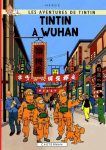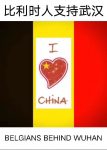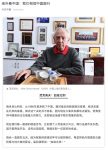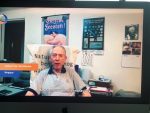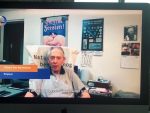Questions and uncertainties
The Covid-19 impacts many businesses, but there is more. The Chinese model is questioned. Alarm lights are flashing for the US-China phase-one trade deal. Observers look at what they call flaws in the Chinese model.
Beijing battles a “crisis of Chernobyl proportions’’ in coronavirus outbreak. Public fury is growing, with calls for more freedom of speech, but most observers don’t expect any dramatic changes.
We all hope for the best and support the efforts to contain the epidemic, but we also hope the Chinese government will learn some lessons.
Watch my short clip of support (need VPN):
https://www.facebook.com/lachineaupresent/videos/2634126666817695/
La Chine vit aujourd’hui un véritable drame collectif déclenché par la propagation du coronavirus. Beaucoup de monde se sont inquiétés de la sécurité des étrangers en Chine. Pour cela, nous les avons donc contactés pour qu’ils partagent avec nous leurs expériences et leur sentiments.La porte-parole du ministère des Affaires étrangères de Chine, Mme Hua Chunying a déclaré le 6 février à la presse, que la Chine continuerait de garantir la sécurité et les soins aux étrangers en Chine ainsi que les soins aux citoyens chinois. Les mesures d’hygiène et de prévention sont traduites en quasiment toutes les langues, les étrangers en Chine peuvent rester au courant de l’évolution de l’épidémie et des règles à respecter. Mais ils ont en colère lorsqu’ils lisent ou regardent certains reportages injustes dans les médias occidentaux. La Chine a pris toute une série de mesures qui donnent maintenant de bons résultats, comme l’a confirmé l’OMS. Tout ce qu’il faut, c’est attendre car les virus obéissent à des cycles. Maintenant, tous les étrangers en Chine font confiance à la Chine. Allez la Chine! Allez Wuhan !
Posted by La Chine au Présent LCAP on Thursday, February 13, 2020
The same clip was also posted on Wechat (with no need for VPN).
Earlier they posted a text version. Some screenshots of the clip.
Uncertainty around the US-China phase-one trade deal
The deal between USA and China was signed when events in Wuhan made key terms doubtful from the start. How could China meet its additional US$200 billion purchase commitments?
And then the coronavirus epidemic made the improbable impossible.
“The coronavirus outbreak could reduce Chinese purchases of US agricultural products this year under the Phase 1 trade deal signed by the two countries”, White House national security adviser Robert O’Brien said as reported by Reuters.
The Chinese government cannot dictate consumer choices. Out of public health concerns, cinemas in China are closed. So, who will watch American films.
Chinese tourists must choose whether they travel to the U.S. or Europe. Major US airlines have stopped flying to mainland China and the US has basically barred the entry of non-American citizens. Reduced travel means also less urgency to buy Boeing jets. Tourism revenue in USA to plummet, even more than in Europe.
Some of the intended contracts need communication and meetings. Difficult now that people can’t travel anymore.
How to implement the inflated purchase promises when there is less Chinese demand and the volumes were too large to start with.
Flaws in the Chinese model
As discussed in the SCMP, the epidemic exposes fundamental flaws in China’s economic model. I have to agree with many of their views, as part of their comments.
Beijing is reluctant to fix it, as it does not want to tackle the excessive concentration of power, with information and resources now more and more in the hands of a powerful state, read, of the Party.
Beijing will continue to strengthen centralized control, and that’s is a greater threat for China’s future than the virus itself.
China can build a hospital in ten days. An overly centralized political system makes it possible for the government to place emphasis on delivering quick and impressive results but also on doing the wrong things, leading to further disaster.
The central government is increasingly reliant on state-owned enterprises and state money to maintain social stability and to deliver economic results, all while the private economy is gradually marginalized.
Many private business owners in China have noticed a change that they are not welcomed or loved in the new system.
China has suffered important capital outflows as many wealthy Chinese people, and even the urban middle class, have scrambled to move money out of the country. Private investment at home has suffered. Some of the people I know only want one thing: get their money out.
In such an increasingly centralized system, decision-making power is concentrated at the top, and information is filtered through the different levels of governments. If the top decision makers prefer stability more than anything else, the system will just automatically suppress and filter out information that can paint a different and unwelcome picture. That is the direct cause of the coronavirus outbreak, which was seriously under-reported or even covered up before January 20, see further.
Economists cited 2003 SARS as an example of how China’s economic growth can recover quickly from the coronavirus outbreak. They ignore the fact that the Chinese economy has completely changed since SARS. That time, China was integrating into the world economy and was dismantling at least in part its state sector economy.
Wuhan messed it up
source BBC: https://www.bbc.co.uk/news/world-asia-china-51449675
On 30 December, Dr. Li Wenliang, an ophthalmologist working in Wuhan’s Central Hospital, posted his concerns in a private medical chat group, advising colleagues to take measures to protect themselves.
A few days later, he was summoned by the police and made to sign a confession, denouncing the messages he’d posted as “illegal behavior”.
The authorities, though, were well aware of the outbreak of illness.
The day after Dr. Li posted his message, China notified the WHO, and the day after that, the suspected source – the market – was closed down.
Doctors were already setting up quarantine rooms and anticipating extra admissions when Wuhan held its important annual political gathering, the city’s People’s Congress. In their speeches, Party leaders made no mention of the virus.
The National Health Commission continued to report that the number of infections was limited and that there was no clear evidence that the disease could spread between humans.
On 18 January the Wuhan authorities allowed a massive community banquet to take place, involving more than 40,000 families. The aim was to set a record for the most dishes served at an event.
Two days later, China finally confirmed that human-to-human transmission was indeed taking place.
Caixin reported that Beijing had its first COVID-19 patient on January 12, Guangdong’s first was January 4, Shanghai’s was January 15.
Just yesterday the government changed the way counting cases of infection and deaths, to improve the former non-transparent way of counting (as mentioned in my previous post). A step forward in transparency. Hubei province reported a spike in new confirmed cases and deaths after change in diagnostic criteria. Now doctors have broader discretion to determine which patients are infected.
